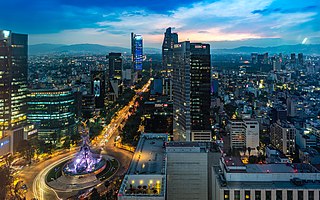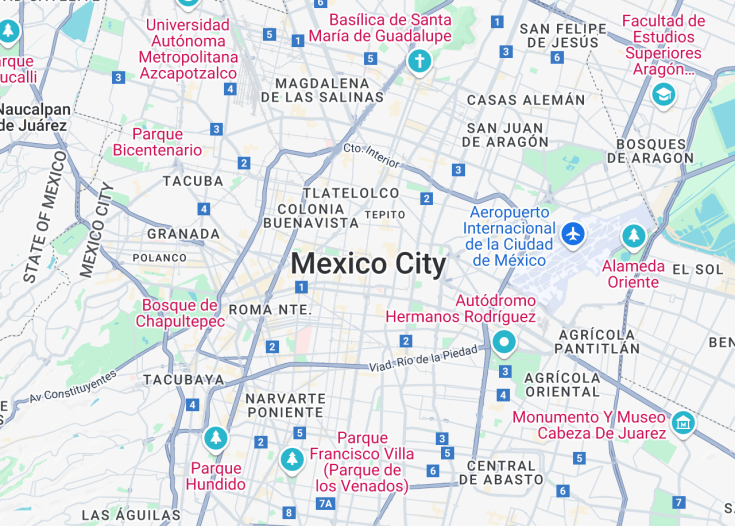Mexico City, the vibrant capital of Mexico, is a captivating blend of history and modernity. As the oldest capital city in the Americas and one of the largest cities in the world, it offers an expansive cultural landscape. The historic center, known as ‘El Centro,’ features architectural marvels from the colonial period alongside ancient ruins. The city is renowned for its world-class museums, diverse culinary scene, and lively markets. Whether exploring the bohemian neighborhoods or the spacious Chapultepec Park, Mexico City promises a unique, culturally rich experience for every visitor.
When visiting Mexico City, always carry some cash; many local markets and street vendors do not accept credit cards.
Plan to visit major attractions early in the morning to avoid crowds and experience the city’s landmarks more intimately.
Top things to do & see in Mexico City
Select the following sights and activities to discover best tickets and tours available in Mexico City.
Mexico City: The Heart of Mexican Heritage
| Country | Mexico |
| Time in Mexico City | GMT-6 |
| Language spoken | Spanish |
| Population | 21,782,378 (World Population Review) |
| Currency | Mexican Peso (MXN $) |
| Airports |
|
Welcome to Mexico City, a vibrant metropolis brimming with rich history and cultural diversity. As one of the largest cities in the world, Mexico City stands as a powerhouse of economic, political, and cultural activities in Mexico. Its storied past stretches back to its days as Tenochtitlan, the heart of the Aztec Empire, making it a significant archaeological and historical site. Today, the city is adorned with an eclectic blend of colonial architecture and modern skyscrapers, encapsulating its evolution through centuries.
With a sprawling urban area, the city is a confluent point for tradition and modernity. It’s home to renowned museums like the Frida Kahlo Museum and the National Museum of Anthropology, which showcase vast collections of pre-Hispanic to contemporary art. Mexico City is also famed for its unique culinary scene, mixing indigenous and international flavors to offer an exquisite gastronomic experience.
The city’s extensive public transportation system facilitates exploration of its countless neighborhoods, each with distinct characteristics. From the historic downtown area – a UNESCO World Heritage Site filled with monumental landmarks such as the Palacio Nacional and the Mexico City Metropolitan Cathedral – to trendier zones like Condesa and Polanco, where luxury boutiques, parks, and an array of cafes and restaurants can be found.
Mexico City also serves as a central hub for various sectors including education, with numerous prestigious universities and research institutions. It’s a place where heritage meets innovation, seen in its thriving arts scene, bustling markets, and energetic nightlife. Each aspect of the city offers a deeper understanding of the Mexican spirit, making it a compelling destination for tourists and business travelers alike.
Where is Mexico City?
Located in the Anáhuac Valley surrounded by mighty mountain ranges, Mexico City sits at roughly the center of Mexico, resting at an altitude of approximately 2,240 meters above sea level.
Distances:
| Route | Distance by car | Time by car |
|---|---|---|
| Mexico City to Monterrey | 560 mi (901 km) | Approx 9 hours |
| Mexico City to Guadalajara | 340 mi (547 km) | Approx 6 hours |
| Mexico City to Cancun | 1,000 mi (1,609 km) | Approx 20 hours |
What is Mexico City famous for?
Mexico City is renowned for its rich cultural heritage, vibrant street life, and as the epicenter of power in Mexico. It boasts impressive landmarks, like the Zócalo and the National Palace, beside an array of museums and historical sites.
History
Pre-Hispanic Period (before 1521)
Mexico City, originally known as Tenochtitlan, was founded by the Mexica people around the year 1325. Situated on an island in the middle of Lake Texcoco, it became the capital of the expanding Aztec Empire in the 15th century, ultimately becoming the largest and most powerful city in Mesoamerica. The city was noted for its sophisticated urban layout and the monumental Templo Mayor, dedicated to the gods Tlaloc and Huitzilopochtli.
Colonial Period (1521–1821)
After the Spanish conquest led by Hernán Cortés in 1521, Tenochtitlan was destroyed and rebuilt as Mexico City, the capital of the Vice-royalty of New Spain. This period saw the construction of many significant colonial buildings, including the Mexico City Metropolitan Cathedral, which stands today as the largest cathedral in the Americas. The city also became the political, administrative, economic, and cultural hub of Spanish America.
19th Century and the Mexican Independence (1821–1900)
Following Mexico’s independence from Spain in 1821, Mexico City became the capital of the newly formed nation. The century was marked by instability, including a brief French occupation and the rule of Emperor Maximilian I. The Reform War and the subsequent imposition of liberal reforms significantly affected the city’s development, both socially and physically.
20th Century to Present
The 20th century was a time of dramatic change and modernization for Mexico City. The Mexican Revolution in the early 1900s led to significant social and political upheaval. Post-revolution, the city underwent substantial urbanization to accommodate rapid population growth. This period also saw the emergence of major cultural movements in art, literature, and music, prominently featuring figures like Frida Kahlo and Diego Rivera. Today, Mexico City is a bustling metropolis that serves as Mexico’s political, cultural, and financial center, reflecting a blend of its historical heritage and modern-day vibrancy.
Visit Mexico City
What to see and do in Mexico City, Mexico
Visitors to Mexico City can explore a wealth of cultural, historical, and architectural attractions. Key sights include the historic center with the Zocalo plaza and the aforementioned Mexico City Metropolitan Cathedral. The Palacio de Bellas Artes and the vast Chapultepec Park are also not to be missed. For museum enthusiasts, the Frida Kahlo Museum and the National Museum of Anthropology offer fascinating insights into Mexican heritage and art. Foodies will enjoy the bustling markets like La Merced and upscale dining in neighborhoods such as Polanco.
Cultural festivals and events
Mexico City is home to numerous annual events that highlight its rich cultural tapestry. The Day of the Dead celebrations, particularly around the first and second of November, are a vibrant and colorful affair with citywide festivities, including parades and altars. The springtime brings the Festival del Centro Histórico, a cultural festival featuring music, theatre, dance, and more, predominantly held in the historical center. Another significant event is the Guelaguetza, celebrating the indigenous cultures of Oaxaca but also prominently featured in Mexico City with performances and crafts.
Best time to visit Mexico City
The best time to visit Mexico City is during the spring months of March and April when the weather is most pleasant. The city generally enjoys mild temperatures, less rainfall, and blooming jacarandas that add a splash of color to its landscapes. Another good time is in the autumn, particularly around the culturally rich celebrations of the Day of the Dead.
is Mexico City worth visiting?
Mexico City offers a unique blend of historic grandeur and contemporary culture, making it a compelling destination for travelers. Its rich history is palpable in every corner, from ancient ruins to colonial architecture and modern art movements. The city is also home to an incredible culinary scene, from street food like tacos and tamales to gourmet restaurants. However, visitors should be mindful of the city’s high altitude and potential for traffic congestion. Safety in certain areas can be a concern, though tourist neighborhoods are generally well-policed and safe. Overall, for those interested in art, culture, and history, Mexico City is undoubtedly worth a visit.
What is the best time of year to visit Mexico City?
What are some must-visit cultural sites in Mexico City?
- Templo Mayor: A significant archaeological site, providing insight into the Aztec civilization before the Spanish conquest.
- The Frida Kahlo Museum: Also known as “La Casa Azul,” this was the blue-painted home of the famous Mexican artist Frida Kahlo.
- Palacio de Bellas Artes: A stunning cultural venue known for its detailed murals by famous Mexican painters and diverse arts performances, including ballet, opera, and classical music.
- National Museum of Anthropology: One of the most important museum sites in Mexico, featuring vast collections of artifacts from Mexico’s pre-Columbian heritage.
- Chapultepec Castle: Situated in one of the largest city parks globally, this historic building serves as a museum and offers panoramic views of the city.
Exploring these sites gives a comprehensive glimpse into the rich history and vibrant culture of Mexico City.
Where can I try authentic Mexican cuisine in Mexico City?
- Pujol: Renowned globally for its innovative approach to traditional Mexican dishes, offering a unique culinary experience.
- Quintonil: Provides a contemporary twist on indigenous Mexican ingredients, making it a must-visit for food enthusiasts.
- El Cardenal: A great spot to taste traditional dishes such as tamales, chilaquiles, and atole.
- Street Food: For more casual fare, the street food in Mexico City is a must-try, with tacos, tlayudas, and elotes being popular choices.
These establishments and experiences provide a deep dive into the flavors that define Mexican cuisine.












